Anna Fleming explores a strange and miraculous fungal world at the Royal Botanic Garden Edinburgh.
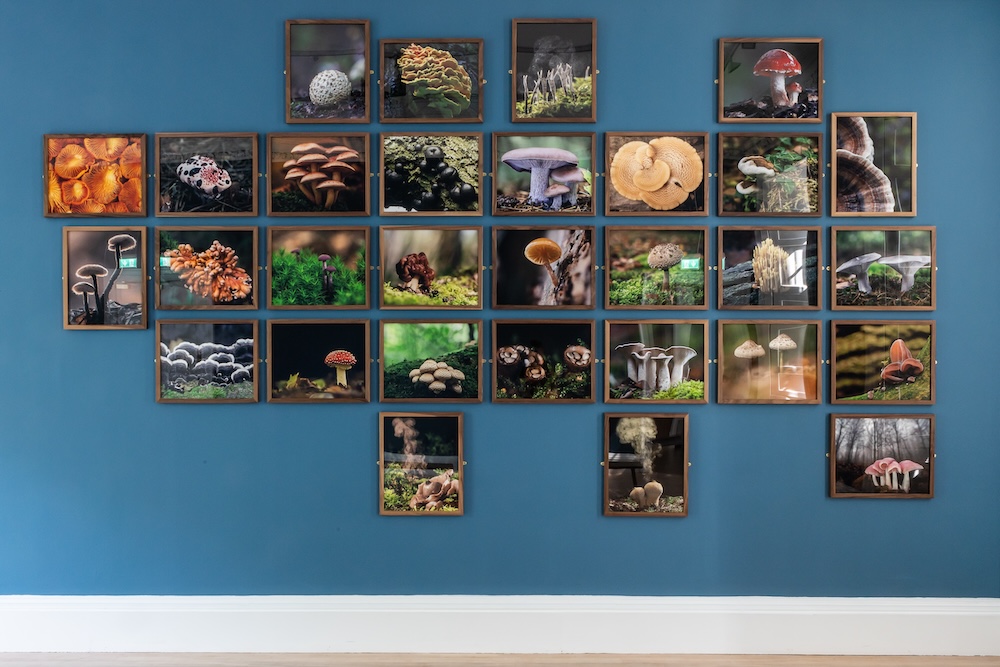
Givers of life. Managers of death. Protectors and restorers of natural habitats. Fungi are strange and miraculous organisms: a new exhibition at the Royal Botanic Garden Edinburgh puts these wonders centre-stage.
In the first room, a wall of photographs like a family gallery, capturing fungi in some of their peculiar forms as found within the Botanic Gardens. They’re yellow, white, brown and red. There are toadstools and puff-balls, devil’s tooth and chicken of the woods. Chanterelle, wood ear and turkey tail. The common names are the language of poetry, the dance between nature and metaphor; magic and mimicry.
One of the portraits captures a mushroom taking on the oddest of forms, looking uncannily, preposterousluy like something else, but how is it possible? My mind is stumped by the image yet the name confirms what I think I see. Common birds nest fungus: a mushroom that looks exactly like a bird’s nest with tiny white eggs inside. Absurd. On the upper row, candlesnuff is shot at night. Lit up in the darkness, the fungus appears almost human, little figures with their arms upraised, emitting spores, as though they are dancers in a night-time ritual. The haunting picture leaves me wondering, do mushrooms make art?
Fungi invite us to think in different ways. Their mysterious life-forms harbour a rich seam for intellectual and creative exploration that has exploded in recent years. The exhibition immerses us in the zone where art meets science and science meets art. It is a testing ground that challenges my senses and preconceptions. Working with these organisms, it seems there is infinite knowledge to discover and new things to create. The thing to be known grows with the knowing.
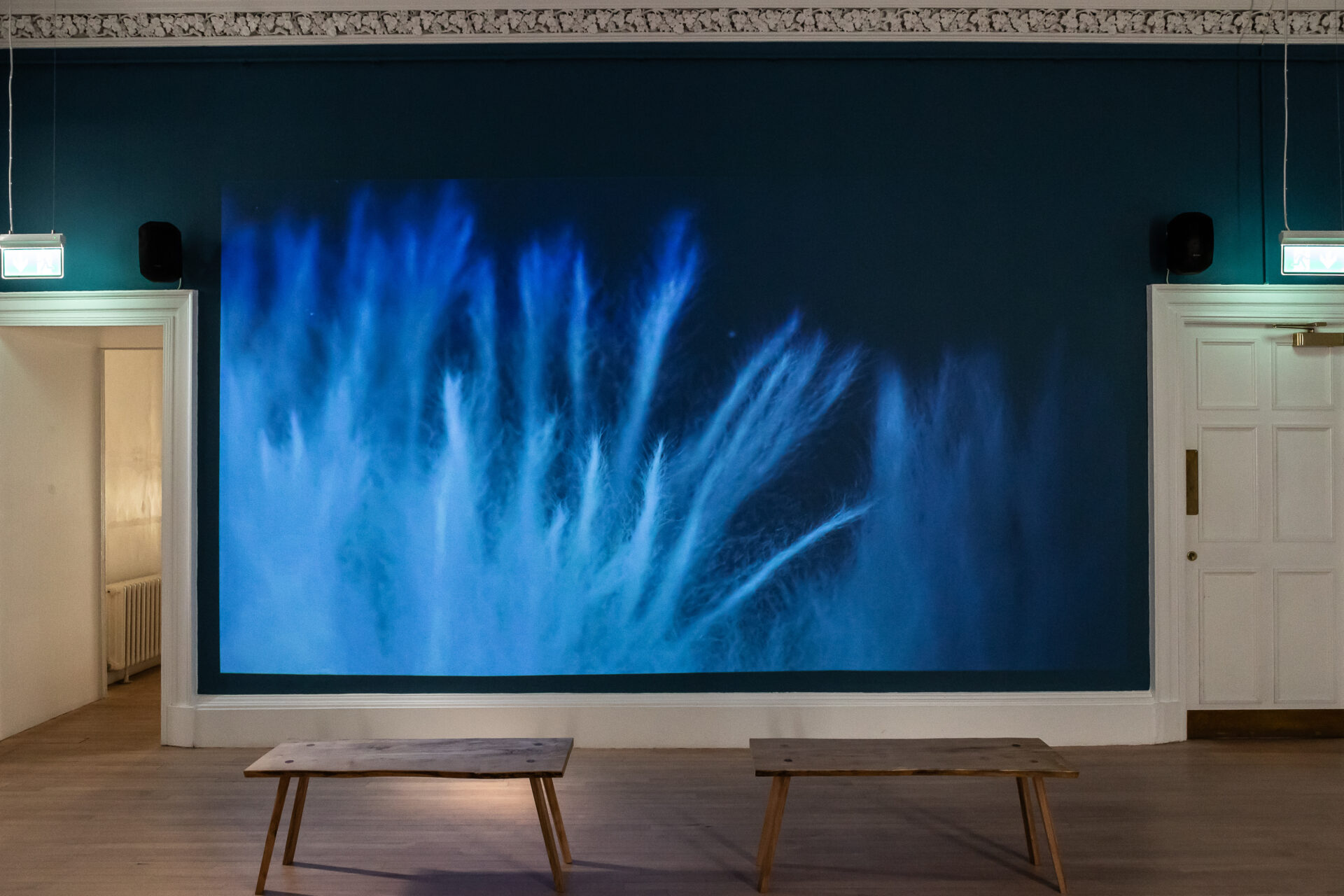
A film of microscopic timelapse shows the growth of stinkhorn mycelium. Tiny little fungal threads — hyphae — spread across the screen, accompanied by banjo and violin in ‘Silverphae’, a folk song composed by artist Hannah Read. Her album The Fungi Sessions Vol. 1 is dedicated to her father, Nick Read who was a pioneering fungal cell biologist. (More science and art, overlapping in the tangled texture of life.) Watching the hypnotic mycelium growth evokes another image, one of human neural pathways growing and expanding. The mirror is revealing. It seems to show how the fungal provocation is inviting creative thinkers to expand their knowledge; and their curiosity is leading our collective thought into new spaces.
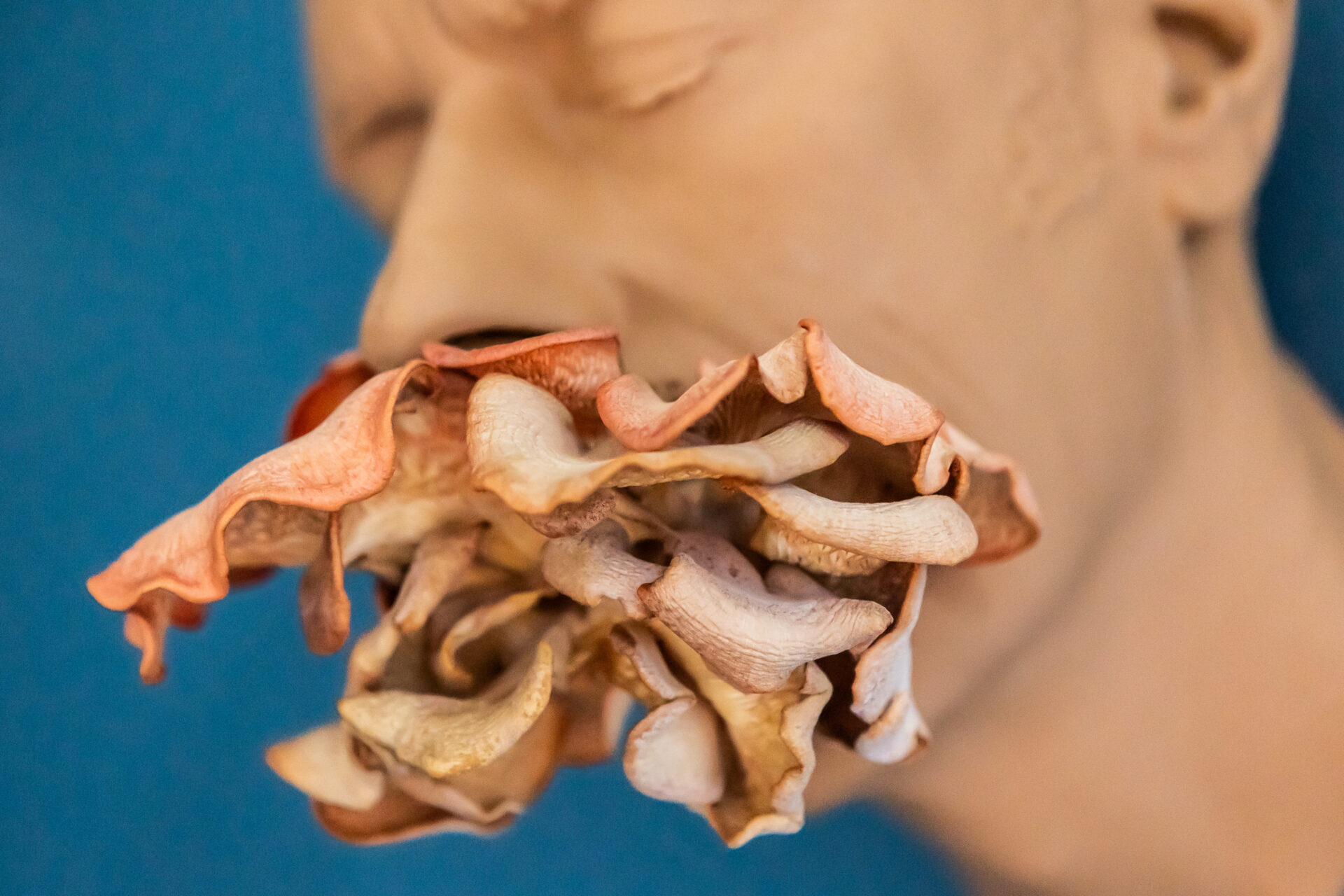
In a corner of the room there are three 3D scans of an artist’s head that have been adapted so that fungi can live inside the biotope. The result is both unsettling and beautiful. Oyster mushrooms bloom like flowers from the open mouth and nostrils of one of the heads. Are they speech bubbles? What is the fungus saying?
A trail of tiny little bronze mushrooms ‘growing’ out of the walls leads me out of the room and up the stairs. The bronze casts were made by artist Jo Coupe in an installation titled Infester, showing how nature can erode domestic boundaries. An earthy smell pervades the upper rooms: the exhibition is becoming increasingly immersive. I find the source — hundreds of dried shitake, laid out loose like flowers on the ground.

A room on food — cheese, yeast, mould, marmite — shows how the fungus feeds our bodies. Next door, another surprise: Stella McCartney. In an environmental take on fashion, McCartney has turned her hand to fungi. Dresses in the centre of the room feature fun-gal prints but stranger still are the plain black ‘unleather’ pieces – a handbag, a bustier and trousers. The vegan trousers were made from Mylo, a fabric made from mycelium grown from in a vertical farm. Are mushroom trousers at the forefront of eco-fashion?

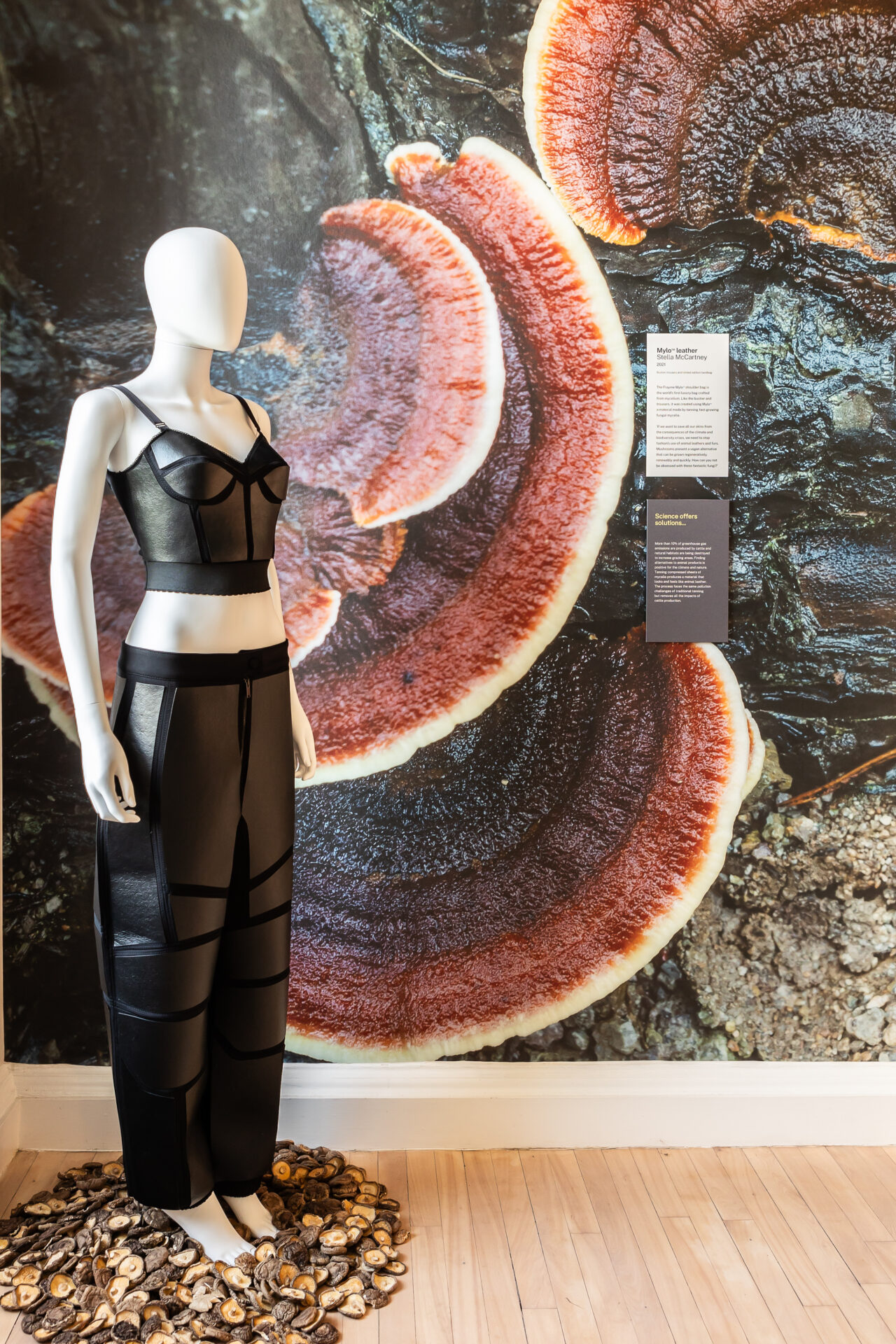
A library showcases fungi’s hold on our imagination and a record-player allows me to play the mushroom-inspired vinyl of my choice. The records strike trippy notes with everything from 70s psychedelia to Cosmo Sheldrake and Jon Hopkins’ Music for Psychedlic Therapy. I am tempted by The Smurfing Sing-Song but then there’s Björk’s ‘mushroom album’ Fossara, released after the death of her mother. H is for Hawk; M is for Mushroom: can fungi heal grief?
On the wall in the library I find a quote from a piece I wrote for Caught by the River in 2021 on chanterelles. The piece was titled ‘An Earthy Inheritance’, tracing some of the connections between people and mushrooms and celebrating how fungi can help us connect with nature and one another. When putting Fungi Forms together, curator Amy Pourteous said she met aversion and phobic reactions among local people, which surprised her. She wanted an explanation for this cultural phenomenon:
To my Czech, Latvian and Polish friends, there is nothing strange about mushroom-gathering in the forest. In fact, they are bemused by us Brits. Why don’t more of us go foraging in the forest? How to explain the centuries of exclusion, trespassing laws and deforestation that has unpicked so many of our cultural and ecological ties to the forest?
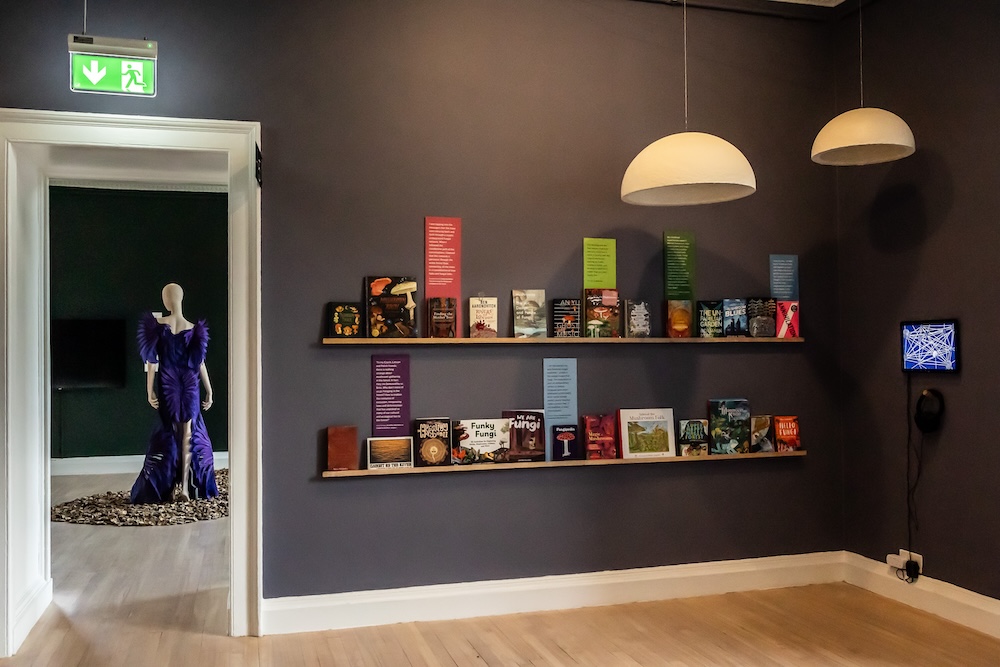
There is a conceptual bent to all this work. One starts to grasp how fungi are helping artists to think, dream and imagine; while scientists pursue parallel lines of inquiry. The knowledge is enriching, as the exhibition makes clear. We meet mould, the source of penicillin, psilocybin for mental health and a fungus that can repair damaged concrete. Fungi is giving us new solutions for a range of problems.
The exhibition is expertly curated, engaging all the senses in a mind-bending fusion of nature, art and science, revealing how the disciplines are at the cutting edge of rich new natural knowledge. Complex and mysterious. Givers of life. Problem solvers. With their role in everything from chemistry to medicine, food, arts and technology, fungi offer myriad ways for us to develop on this planet. In our critical moment of climate and biodiversity crisis, we find the mycelium of hope.
*
‘Fungi Forms’ is on display at the Royal Botanic Garden Edinburgh until 8th December. Find visiting information here.